Clinical Practice Improvement for Hand Hygiene in Healthcare Settings
VerifiedAdded on 2020/12/23
|10
|2851
|183
Report
AI Summary
This report investigates clinical governance and hand hygiene practices within healthcare settings, focusing on the need for improved hand hygiene to prevent infections. It addresses the relevance of clinical governance, emphasizing its role in creating a safe environment for patients and staff, and highlights the use of Clinical Practice Improvement (CPI) tools to address hand hygiene issues. The report examines key stakeholders, proposed interventions, and barriers to implementation, such as lack of training and carelessness. It also provides evidence from guidelines and surveys, emphasizing the importance of effective training programs and the integration of hand hygiene into clinical governance. The report concludes with an evaluation of the project, aiming to enhance the quality of healthcare services and patient safety by promoting better hand hygiene practices.
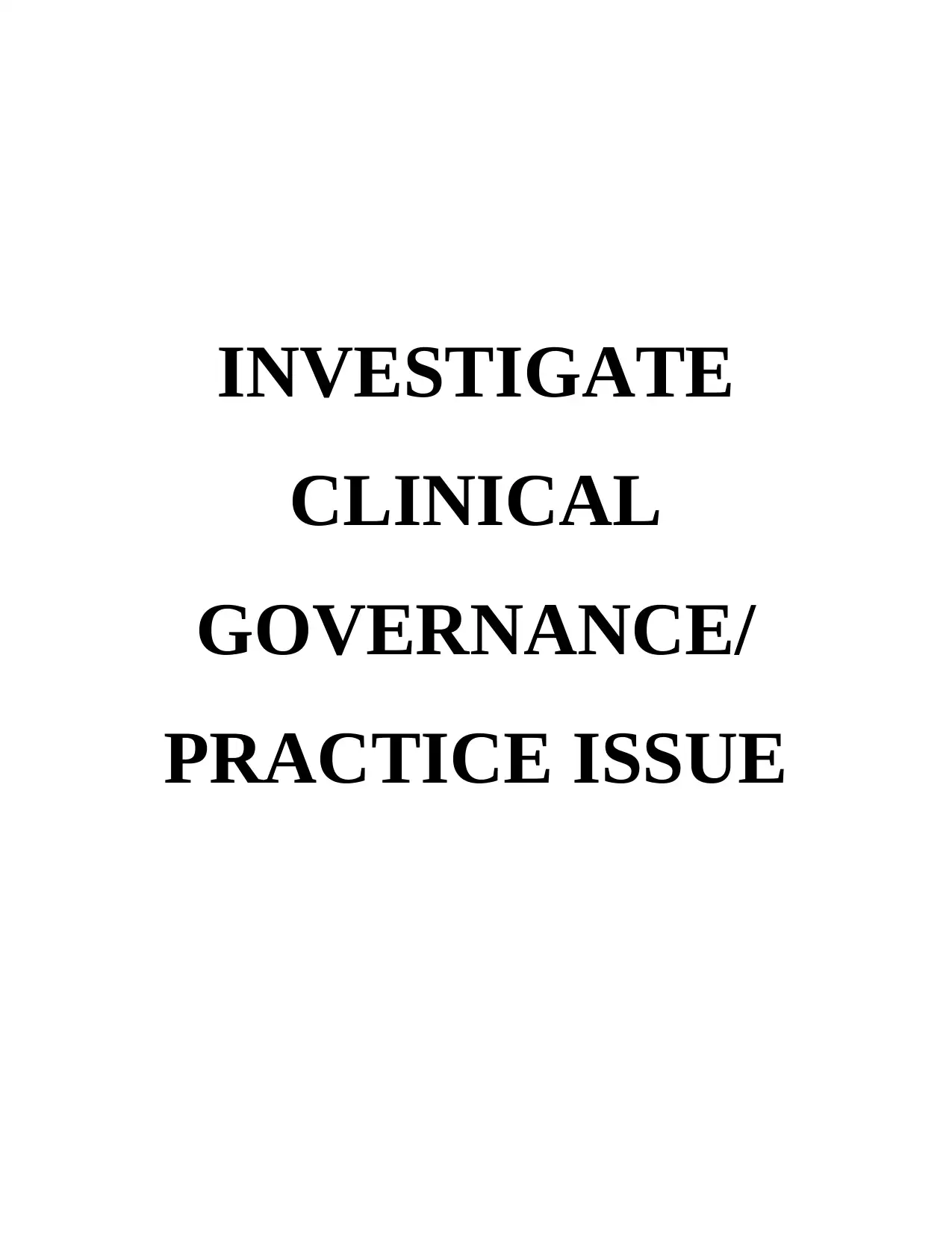
INVESTIGATE
CLINICAL
GOVERNANCE/
PRACTICE ISSUE
CLINICAL
GOVERNANCE/
PRACTICE ISSUE
Paraphrase This Document
Need a fresh take? Get an instant paraphrase of this document with our AI Paraphraser
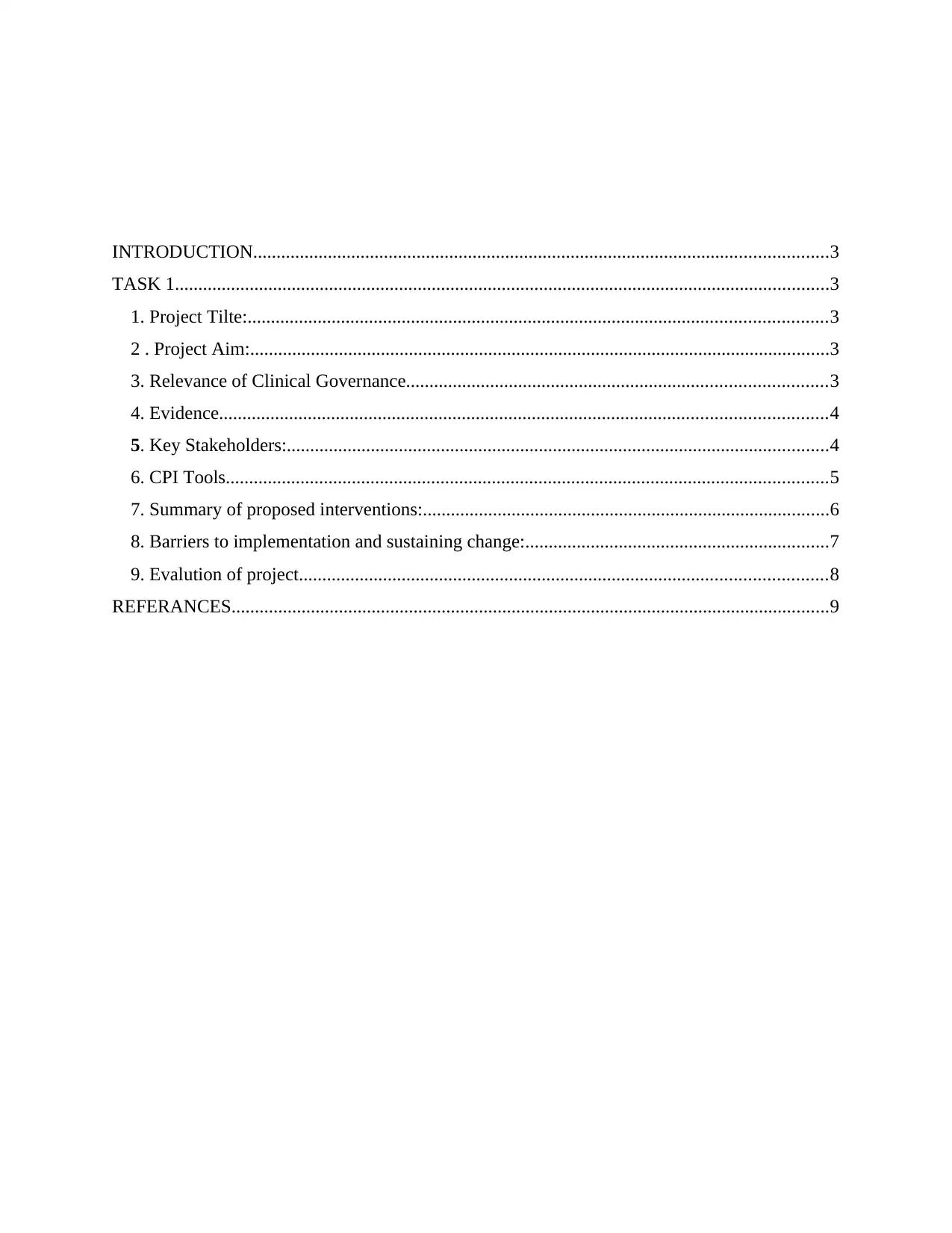
INTRODUCTION...........................................................................................................................3
TASK 1............................................................................................................................................3
1. Project Tilte:............................................................................................................................3
2 . Project Aim:............................................................................................................................3
3. Relevance of Clinical Governance..........................................................................................3
4. Evidence..................................................................................................................................4
5. Key Stakeholders:....................................................................................................................4
6. CPI Tools.................................................................................................................................5
7. Summary of proposed interventions:.......................................................................................6
8. Barriers to implementation and sustaining change:.................................................................7
9. Evalution of project.................................................................................................................8
REFERANCES................................................................................................................................9
TASK 1............................................................................................................................................3
1. Project Tilte:............................................................................................................................3
2 . Project Aim:............................................................................................................................3
3. Relevance of Clinical Governance..........................................................................................3
4. Evidence..................................................................................................................................4
5. Key Stakeholders:....................................................................................................................4
6. CPI Tools.................................................................................................................................5
7. Summary of proposed interventions:.......................................................................................6
8. Barriers to implementation and sustaining change:.................................................................7
9. Evalution of project.................................................................................................................8
REFERANCES................................................................................................................................9
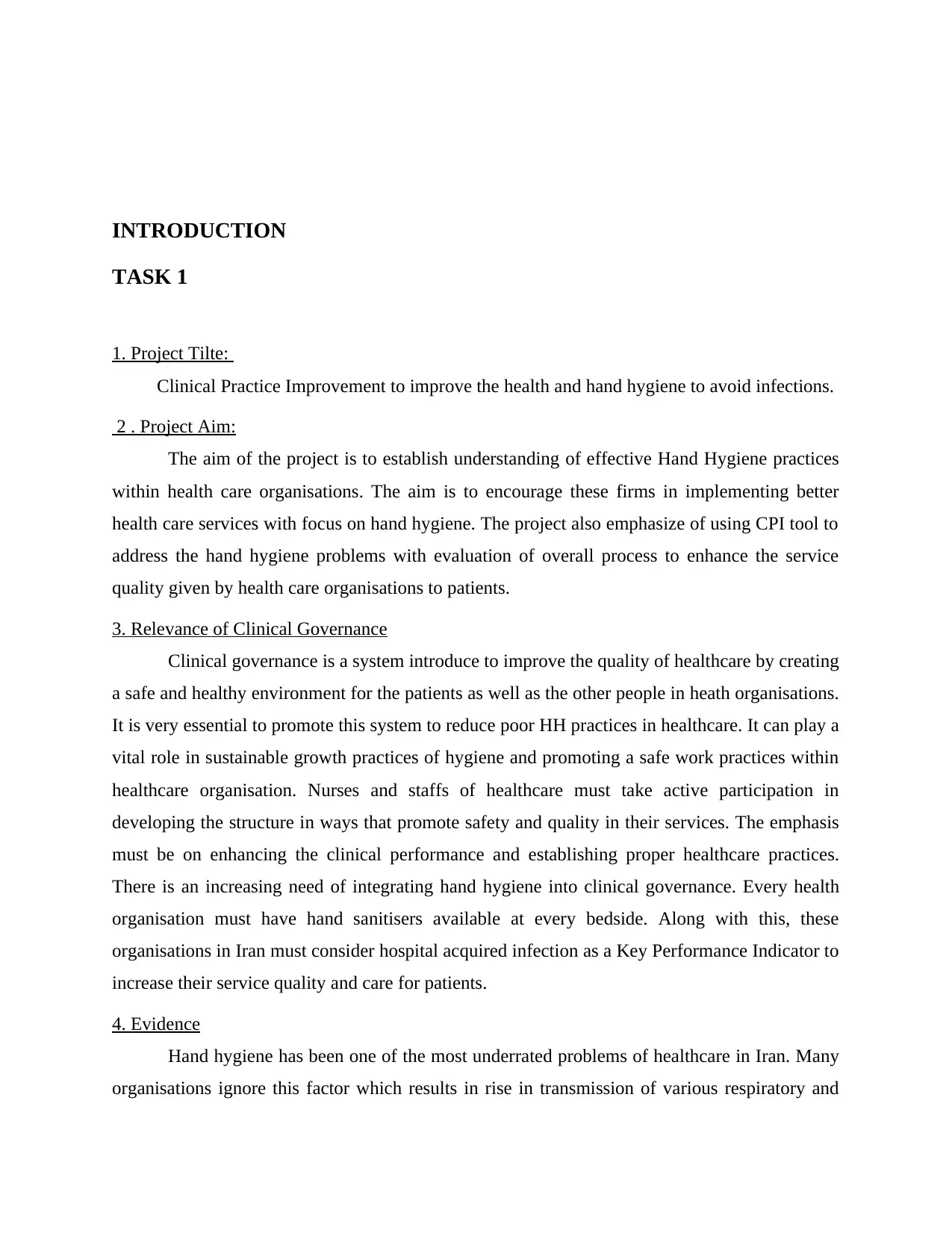
INTRODUCTION
TASK 1
1. Project Tilte:
Clinical Practice Improvement to improve the health and hand hygiene to avoid infections.
2 . Project Aim:
The aim of the project is to establish understanding of effective Hand Hygiene practices
within health care organisations. The aim is to encourage these firms in implementing better
health care services with focus on hand hygiene. The project also emphasize of using CPI tool to
address the hand hygiene problems with evaluation of overall process to enhance the service
quality given by health care organisations to patients.
3. Relevance of Clinical Governance
Clinical governance is a system introduce to improve the quality of healthcare by creating
a safe and healthy environment for the patients as well as the other people in heath organisations.
It is very essential to promote this system to reduce poor HH practices in healthcare. It can play a
vital role in sustainable growth practices of hygiene and promoting a safe work practices within
healthcare organisation. Nurses and staffs of healthcare must take active participation in
developing the structure in ways that promote safety and quality in their services. The emphasis
must be on enhancing the clinical performance and establishing proper healthcare practices.
There is an increasing need of integrating hand hygiene into clinical governance. Every health
organisation must have hand sanitisers available at every bedside. Along with this, these
organisations in Iran must consider hospital acquired infection as a Key Performance Indicator to
increase their service quality and care for patients.
4. Evidence
Hand hygiene has been one of the most underrated problems of healthcare in Iran. Many
organisations ignore this factor which results in rise in transmission of various respiratory and
TASK 1
1. Project Tilte:
Clinical Practice Improvement to improve the health and hand hygiene to avoid infections.
2 . Project Aim:
The aim of the project is to establish understanding of effective Hand Hygiene practices
within health care organisations. The aim is to encourage these firms in implementing better
health care services with focus on hand hygiene. The project also emphasize of using CPI tool to
address the hand hygiene problems with evaluation of overall process to enhance the service
quality given by health care organisations to patients.
3. Relevance of Clinical Governance
Clinical governance is a system introduce to improve the quality of healthcare by creating
a safe and healthy environment for the patients as well as the other people in heath organisations.
It is very essential to promote this system to reduce poor HH practices in healthcare. It can play a
vital role in sustainable growth practices of hygiene and promoting a safe work practices within
healthcare organisation. Nurses and staffs of healthcare must take active participation in
developing the structure in ways that promote safety and quality in their services. The emphasis
must be on enhancing the clinical performance and establishing proper healthcare practices.
There is an increasing need of integrating hand hygiene into clinical governance. Every health
organisation must have hand sanitisers available at every bedside. Along with this, these
organisations in Iran must consider hospital acquired infection as a Key Performance Indicator to
increase their service quality and care for patients.
4. Evidence
Hand hygiene has been one of the most underrated problems of healthcare in Iran. Many
organisations ignore this factor which results in rise in transmission of various respiratory and
⊘ This is a preview!⊘
Do you want full access?
Subscribe today to unlock all pages.

Trusted by 1+ million students worldwide
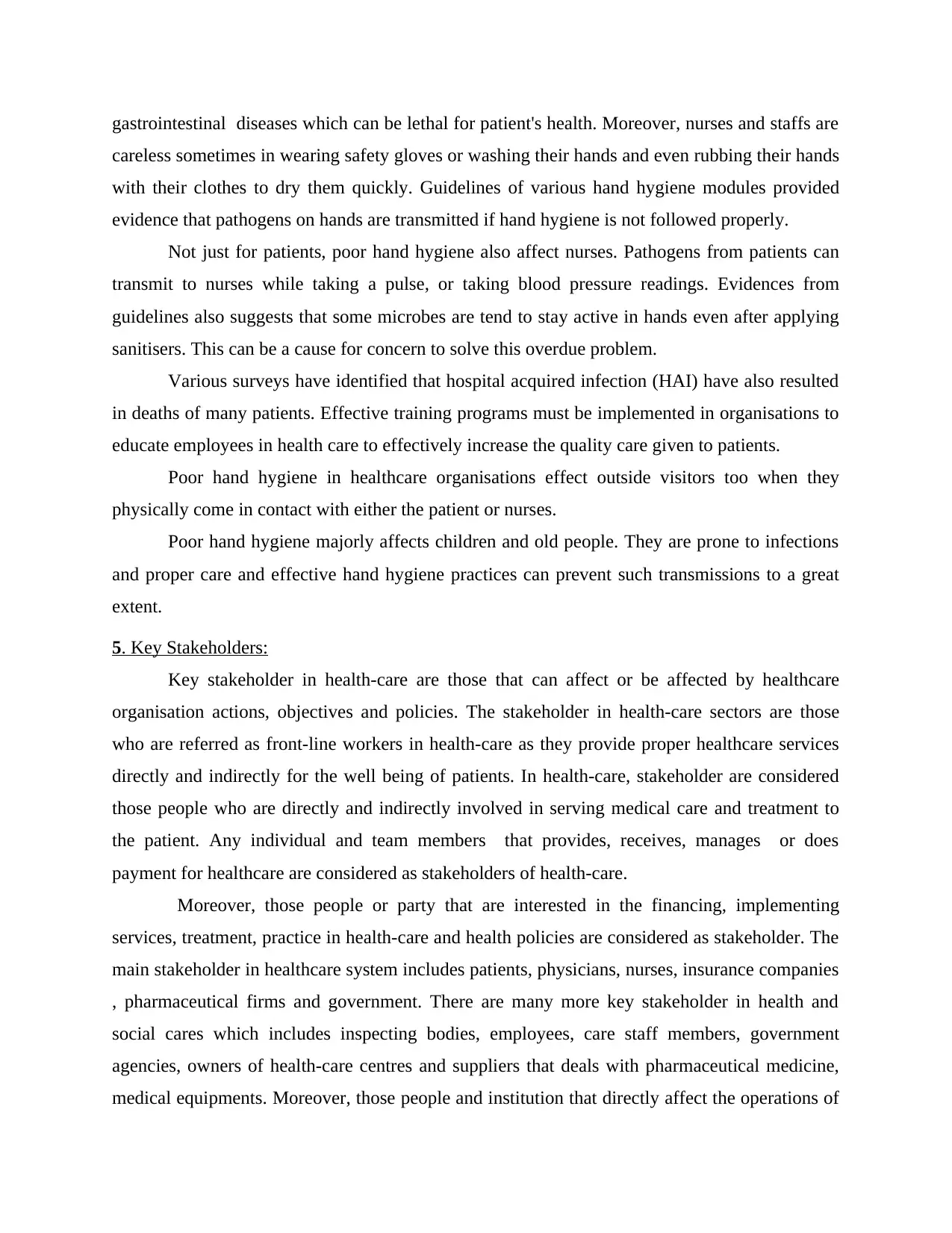
gastrointestinal diseases which can be lethal for patient's health. Moreover, nurses and staffs are
careless sometimes in wearing safety gloves or washing their hands and even rubbing their hands
with their clothes to dry them quickly. Guidelines of various hand hygiene modules provided
evidence that pathogens on hands are transmitted if hand hygiene is not followed properly.
Not just for patients, poor hand hygiene also affect nurses. Pathogens from patients can
transmit to nurses while taking a pulse, or taking blood pressure readings. Evidences from
guidelines also suggests that some microbes are tend to stay active in hands even after applying
sanitisers. This can be a cause for concern to solve this overdue problem.
Various surveys have identified that hospital acquired infection (HAI) have also resulted
in deaths of many patients. Effective training programs must be implemented in organisations to
educate employees in health care to effectively increase the quality care given to patients.
Poor hand hygiene in healthcare organisations effect outside visitors too when they
physically come in contact with either the patient or nurses.
Poor hand hygiene majorly affects children and old people. They are prone to infections
and proper care and effective hand hygiene practices can prevent such transmissions to a great
extent.
5. Key Stakeholders:
Key stakeholder in health-care are those that can affect or be affected by healthcare
organisation actions, objectives and policies. The stakeholder in health-care sectors are those
who are referred as front-line workers in health-care as they provide proper healthcare services
directly and indirectly for the well being of patients. In health-care, stakeholder are considered
those people who are directly and indirectly involved in serving medical care and treatment to
the patient. Any individual and team members that provides, receives, manages or does
payment for healthcare are considered as stakeholders of health-care.
Moreover, those people or party that are interested in the financing, implementing
services, treatment, practice in health-care and health policies are considered as stakeholder. The
main stakeholder in healthcare system includes patients, physicians, nurses, insurance companies
, pharmaceutical firms and government. There are many more key stakeholder in health and
social cares which includes inspecting bodies, employees, care staff members, government
agencies, owners of health-care centres and suppliers that deals with pharmaceutical medicine,
medical equipments. Moreover, those people and institution that directly affect the operations of
careless sometimes in wearing safety gloves or washing their hands and even rubbing their hands
with their clothes to dry them quickly. Guidelines of various hand hygiene modules provided
evidence that pathogens on hands are transmitted if hand hygiene is not followed properly.
Not just for patients, poor hand hygiene also affect nurses. Pathogens from patients can
transmit to nurses while taking a pulse, or taking blood pressure readings. Evidences from
guidelines also suggests that some microbes are tend to stay active in hands even after applying
sanitisers. This can be a cause for concern to solve this overdue problem.
Various surveys have identified that hospital acquired infection (HAI) have also resulted
in deaths of many patients. Effective training programs must be implemented in organisations to
educate employees in health care to effectively increase the quality care given to patients.
Poor hand hygiene in healthcare organisations effect outside visitors too when they
physically come in contact with either the patient or nurses.
Poor hand hygiene majorly affects children and old people. They are prone to infections
and proper care and effective hand hygiene practices can prevent such transmissions to a great
extent.
5. Key Stakeholders:
Key stakeholder in health-care are those that can affect or be affected by healthcare
organisation actions, objectives and policies. The stakeholder in health-care sectors are those
who are referred as front-line workers in health-care as they provide proper healthcare services
directly and indirectly for the well being of patients. In health-care, stakeholder are considered
those people who are directly and indirectly involved in serving medical care and treatment to
the patient. Any individual and team members that provides, receives, manages or does
payment for healthcare are considered as stakeholders of health-care.
Moreover, those people or party that are interested in the financing, implementing
services, treatment, practice in health-care and health policies are considered as stakeholder. The
main stakeholder in healthcare system includes patients, physicians, nurses, insurance companies
, pharmaceutical firms and government. There are many more key stakeholder in health and
social cares which includes inspecting bodies, employees, care staff members, government
agencies, owners of health-care centres and suppliers that deals with pharmaceutical medicine,
medical equipments. Moreover, those people and institution that directly affect the operations of
Paraphrase This Document
Need a fresh take? Get an instant paraphrase of this document with our AI Paraphraser
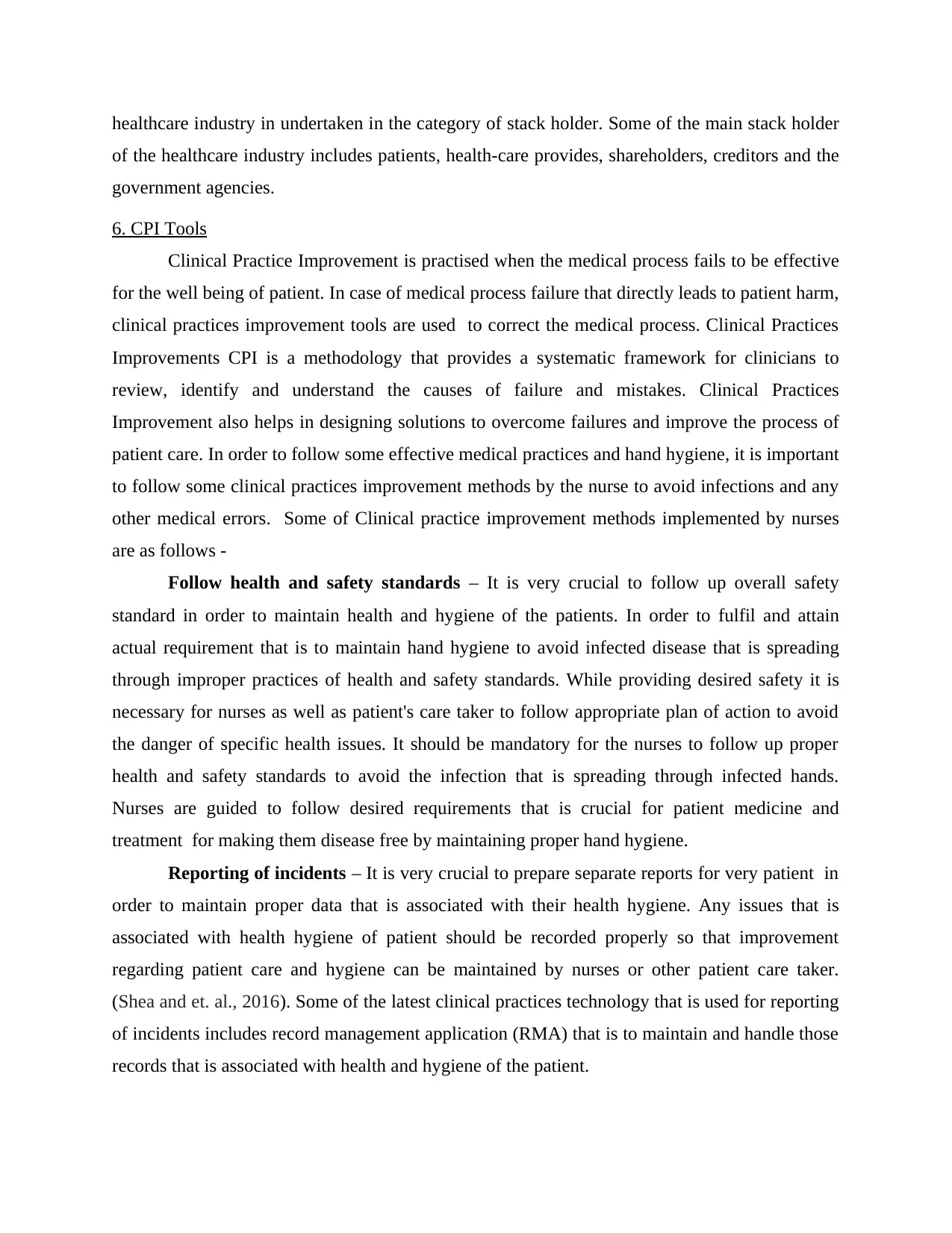
healthcare industry in undertaken in the category of stack holder. Some of the main stack holder
of the healthcare industry includes patients, health-care provides, shareholders, creditors and the
government agencies.
6. CPI Tools
Clinical Practice Improvement is practised when the medical process fails to be effective
for the well being of patient. In case of medical process failure that directly leads to patient harm,
clinical practices improvement tools are used to correct the medical process. Clinical Practices
Improvements CPI is a methodology that provides a systematic framework for clinicians to
review, identify and understand the causes of failure and mistakes. Clinical Practices
Improvement also helps in designing solutions to overcome failures and improve the process of
patient care. In order to follow some effective medical practices and hand hygiene, it is important
to follow some clinical practices improvement methods by the nurse to avoid infections and any
other medical errors. Some of Clinical practice improvement methods implemented by nurses
are as follows -
Follow health and safety standards – It is very crucial to follow up overall safety
standard in order to maintain health and hygiene of the patients. In order to fulfil and attain
actual requirement that is to maintain hand hygiene to avoid infected disease that is spreading
through improper practices of health and safety standards. While providing desired safety it is
necessary for nurses as well as patient's care taker to follow appropriate plan of action to avoid
the danger of specific health issues. It should be mandatory for the nurses to follow up proper
health and safety standards to avoid the infection that is spreading through infected hands.
Nurses are guided to follow desired requirements that is crucial for patient medicine and
treatment for making them disease free by maintaining proper hand hygiene.
Reporting of incidents – It is very crucial to prepare separate reports for very patient in
order to maintain proper data that is associated with their health hygiene. Any issues that is
associated with health hygiene of patient should be recorded properly so that improvement
regarding patient care and hygiene can be maintained by nurses or other patient care taker.
(Shea and et. al., 2016). Some of the latest clinical practices technology that is used for reporting
of incidents includes record management application (RMA) that is to maintain and handle those
records that is associated with health and hygiene of the patient.
of the healthcare industry includes patients, health-care provides, shareholders, creditors and the
government agencies.
6. CPI Tools
Clinical Practice Improvement is practised when the medical process fails to be effective
for the well being of patient. In case of medical process failure that directly leads to patient harm,
clinical practices improvement tools are used to correct the medical process. Clinical Practices
Improvements CPI is a methodology that provides a systematic framework for clinicians to
review, identify and understand the causes of failure and mistakes. Clinical Practices
Improvement also helps in designing solutions to overcome failures and improve the process of
patient care. In order to follow some effective medical practices and hand hygiene, it is important
to follow some clinical practices improvement methods by the nurse to avoid infections and any
other medical errors. Some of Clinical practice improvement methods implemented by nurses
are as follows -
Follow health and safety standards – It is very crucial to follow up overall safety
standard in order to maintain health and hygiene of the patients. In order to fulfil and attain
actual requirement that is to maintain hand hygiene to avoid infected disease that is spreading
through improper practices of health and safety standards. While providing desired safety it is
necessary for nurses as well as patient's care taker to follow appropriate plan of action to avoid
the danger of specific health issues. It should be mandatory for the nurses to follow up proper
health and safety standards to avoid the infection that is spreading through infected hands.
Nurses are guided to follow desired requirements that is crucial for patient medicine and
treatment for making them disease free by maintaining proper hand hygiene.
Reporting of incidents – It is very crucial to prepare separate reports for very patient in
order to maintain proper data that is associated with their health hygiene. Any issues that is
associated with health hygiene of patient should be recorded properly so that improvement
regarding patient care and hygiene can be maintained by nurses or other patient care taker.
(Shea and et. al., 2016). Some of the latest clinical practices technology that is used for reporting
of incidents includes record management application (RMA) that is to maintain and handle those
records that is associated with health and hygiene of the patient.
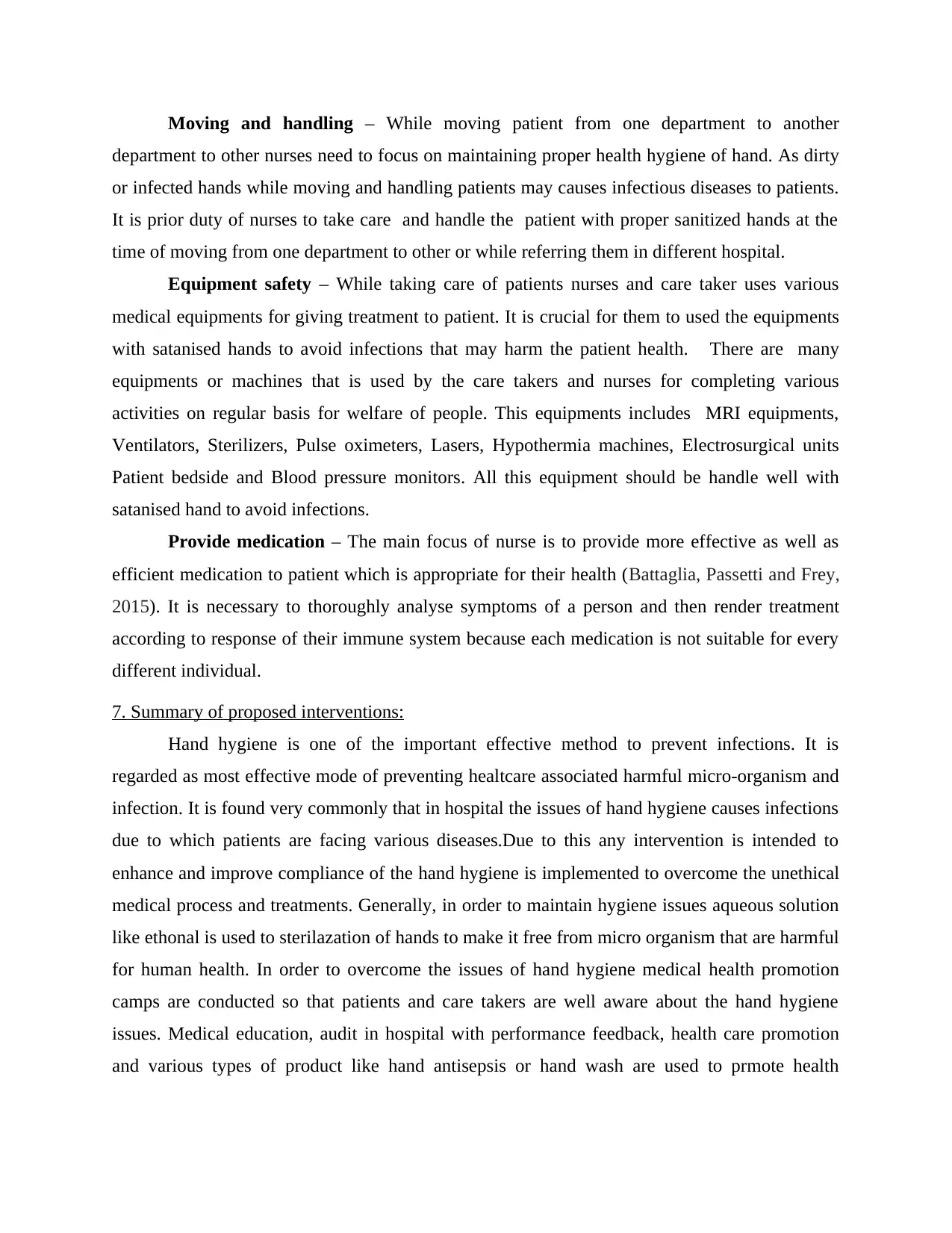
Moving and handling – While moving patient from one department to another
department to other nurses need to focus on maintaining proper health hygiene of hand. As dirty
or infected hands while moving and handling patients may causes infectious diseases to patients.
It is prior duty of nurses to take care and handle the patient with proper sanitized hands at the
time of moving from one department to other or while referring them in different hospital.
Equipment safety – While taking care of patients nurses and care taker uses various
medical equipments for giving treatment to patient. It is crucial for them to used the equipments
with satanised hands to avoid infections that may harm the patient health. There are many
equipments or machines that is used by the care takers and nurses for completing various
activities on regular basis for welfare of people. This equipments includes MRI equipments,
Ventilators, Sterilizers, Pulse oximeters, Lasers, Hypothermia machines, Electrosurgical units
Patient bedside and Blood pressure monitors. All this equipment should be handle well with
satanised hand to avoid infections.
Provide medication – The main focus of nurse is to provide more effective as well as
efficient medication to patient which is appropriate for their health (Battaglia, Passetti and Frey,
2015). It is necessary to thoroughly analyse symptoms of a person and then render treatment
according to response of their immune system because each medication is not suitable for every
different individual.
7. Summary of proposed interventions:
Hand hygiene is one of the important effective method to prevent infections. It is
regarded as most effective mode of preventing healtcare associated harmful micro-organism and
infection. It is found very commonly that in hospital the issues of hand hygiene causes infections
due to which patients are facing various diseases.Due to this any intervention is intended to
enhance and improve compliance of the hand hygiene is implemented to overcome the unethical
medical process and treatments. Generally, in order to maintain hygiene issues aqueous solution
like ethonal is used to sterilazation of hands to make it free from micro organism that are harmful
for human health. In order to overcome the issues of hand hygiene medical health promotion
camps are conducted so that patients and care takers are well aware about the hand hygiene
issues. Medical education, audit in hospital with performance feedback, health care promotion
and various types of product like hand antisepsis or hand wash are used to prmote health
department to other nurses need to focus on maintaining proper health hygiene of hand. As dirty
or infected hands while moving and handling patients may causes infectious diseases to patients.
It is prior duty of nurses to take care and handle the patient with proper sanitized hands at the
time of moving from one department to other or while referring them in different hospital.
Equipment safety – While taking care of patients nurses and care taker uses various
medical equipments for giving treatment to patient. It is crucial for them to used the equipments
with satanised hands to avoid infections that may harm the patient health. There are many
equipments or machines that is used by the care takers and nurses for completing various
activities on regular basis for welfare of people. This equipments includes MRI equipments,
Ventilators, Sterilizers, Pulse oximeters, Lasers, Hypothermia machines, Electrosurgical units
Patient bedside and Blood pressure monitors. All this equipment should be handle well with
satanised hand to avoid infections.
Provide medication – The main focus of nurse is to provide more effective as well as
efficient medication to patient which is appropriate for their health (Battaglia, Passetti and Frey,
2015). It is necessary to thoroughly analyse symptoms of a person and then render treatment
according to response of their immune system because each medication is not suitable for every
different individual.
7. Summary of proposed interventions:
Hand hygiene is one of the important effective method to prevent infections. It is
regarded as most effective mode of preventing healtcare associated harmful micro-organism and
infection. It is found very commonly that in hospital the issues of hand hygiene causes infections
due to which patients are facing various diseases.Due to this any intervention is intended to
enhance and improve compliance of the hand hygiene is implemented to overcome the unethical
medical process and treatments. Generally, in order to maintain hygiene issues aqueous solution
like ethonal is used to sterilazation of hands to make it free from micro organism that are harmful
for human health. In order to overcome the issues of hand hygiene medical health promotion
camps are conducted so that patients and care takers are well aware about the hand hygiene
issues. Medical education, audit in hospital with performance feedback, health care promotion
and various types of product like hand antisepsis or hand wash are used to prmote health
⊘ This is a preview!⊘
Do you want full access?
Subscribe today to unlock all pages.

Trusted by 1+ million students worldwide
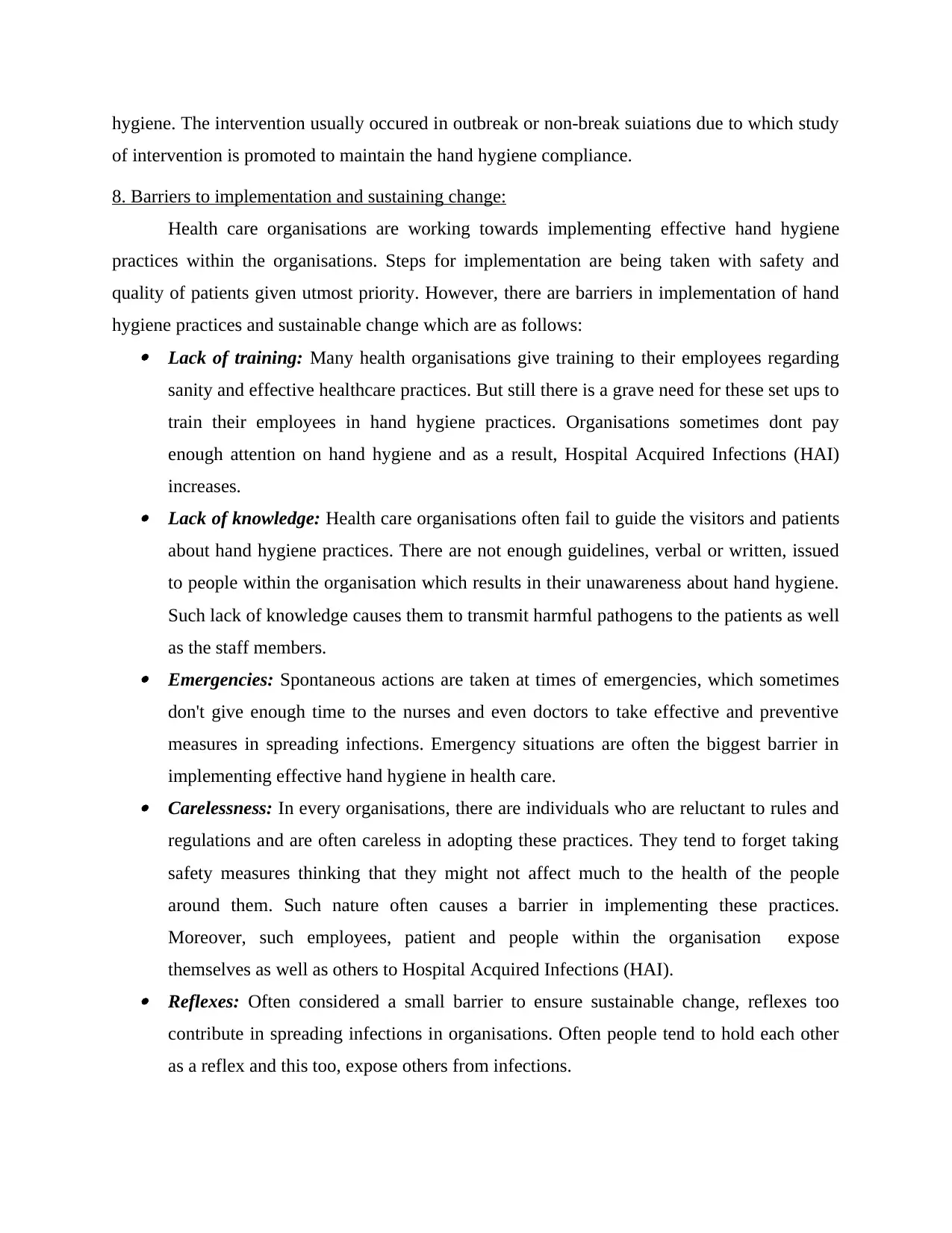
hygiene. The intervention usually occured in outbreak or non-break suiations due to which study
of intervention is promoted to maintain the hand hygiene compliance.
8. Barriers to implementation and sustaining change:
Health care organisations are working towards implementing effective hand hygiene
practices within the organisations. Steps for implementation are being taken with safety and
quality of patients given utmost priority. However, there are barriers in implementation of hand
hygiene practices and sustainable change which are as follows: Lack of training: Many health organisations give training to their employees regarding
sanity and effective healthcare practices. But still there is a grave need for these set ups to
train their employees in hand hygiene practices. Organisations sometimes dont pay
enough attention on hand hygiene and as a result, Hospital Acquired Infections (HAI)
increases. Lack of knowledge: Health care organisations often fail to guide the visitors and patients
about hand hygiene practices. There are not enough guidelines, verbal or written, issued
to people within the organisation which results in their unawareness about hand hygiene.
Such lack of knowledge causes them to transmit harmful pathogens to the patients as well
as the staff members. Emergencies: Spontaneous actions are taken at times of emergencies, which sometimes
don't give enough time to the nurses and even doctors to take effective and preventive
measures in spreading infections. Emergency situations are often the biggest barrier in
implementing effective hand hygiene in health care. Carelessness: In every organisations, there are individuals who are reluctant to rules and
regulations and are often careless in adopting these practices. They tend to forget taking
safety measures thinking that they might not affect much to the health of the people
around them. Such nature often causes a barrier in implementing these practices.
Moreover, such employees, patient and people within the organisation expose
themselves as well as others to Hospital Acquired Infections (HAI). Reflexes: Often considered a small barrier to ensure sustainable change, reflexes too
contribute in spreading infections in organisations. Often people tend to hold each other
as a reflex and this too, expose others from infections.
of intervention is promoted to maintain the hand hygiene compliance.
8. Barriers to implementation and sustaining change:
Health care organisations are working towards implementing effective hand hygiene
practices within the organisations. Steps for implementation are being taken with safety and
quality of patients given utmost priority. However, there are barriers in implementation of hand
hygiene practices and sustainable change which are as follows: Lack of training: Many health organisations give training to their employees regarding
sanity and effective healthcare practices. But still there is a grave need for these set ups to
train their employees in hand hygiene practices. Organisations sometimes dont pay
enough attention on hand hygiene and as a result, Hospital Acquired Infections (HAI)
increases. Lack of knowledge: Health care organisations often fail to guide the visitors and patients
about hand hygiene practices. There are not enough guidelines, verbal or written, issued
to people within the organisation which results in their unawareness about hand hygiene.
Such lack of knowledge causes them to transmit harmful pathogens to the patients as well
as the staff members. Emergencies: Spontaneous actions are taken at times of emergencies, which sometimes
don't give enough time to the nurses and even doctors to take effective and preventive
measures in spreading infections. Emergency situations are often the biggest barrier in
implementing effective hand hygiene in health care. Carelessness: In every organisations, there are individuals who are reluctant to rules and
regulations and are often careless in adopting these practices. They tend to forget taking
safety measures thinking that they might not affect much to the health of the people
around them. Such nature often causes a barrier in implementing these practices.
Moreover, such employees, patient and people within the organisation expose
themselves as well as others to Hospital Acquired Infections (HAI). Reflexes: Often considered a small barrier to ensure sustainable change, reflexes too
contribute in spreading infections in organisations. Often people tend to hold each other
as a reflex and this too, expose others from infections.
Paraphrase This Document
Need a fresh take? Get an instant paraphrase of this document with our AI Paraphraser
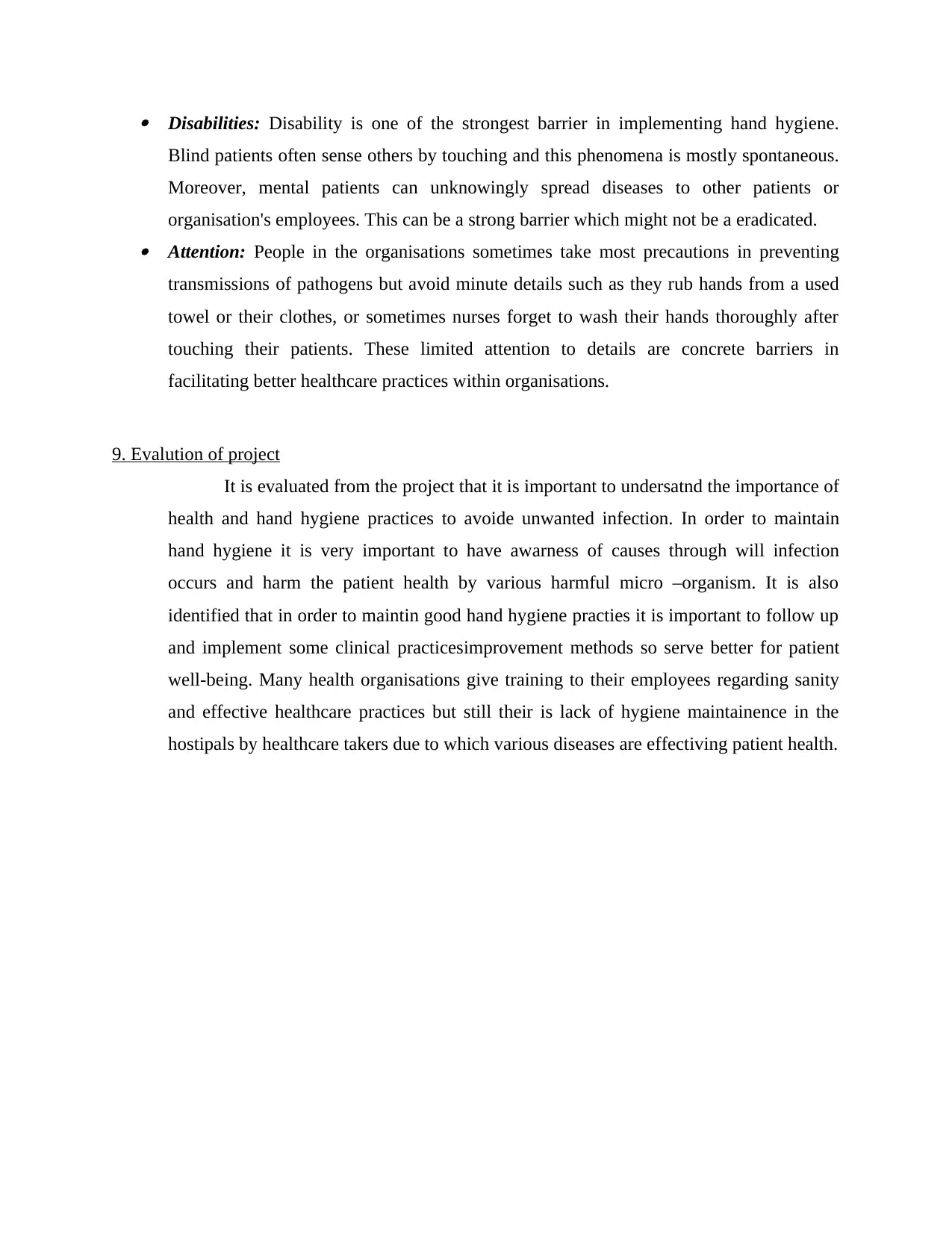
Disabilities: Disability is one of the strongest barrier in implementing hand hygiene.
Blind patients often sense others by touching and this phenomena is mostly spontaneous.
Moreover, mental patients can unknowingly spread diseases to other patients or
organisation's employees. This can be a strong barrier which might not be a eradicated. Attention: People in the organisations sometimes take most precautions in preventing
transmissions of pathogens but avoid minute details such as they rub hands from a used
towel or their clothes, or sometimes nurses forget to wash their hands thoroughly after
touching their patients. These limited attention to details are concrete barriers in
facilitating better healthcare practices within organisations.
9. Evalution of project
It is evaluated from the project that it is important to undersatnd the importance of
health and hand hygiene practices to avoide unwanted infection. In order to maintain
hand hygiene it is very important to have awarness of causes through will infection
occurs and harm the patient health by various harmful micro –organism. It is also
identified that in order to maintin good hand hygiene practies it is important to follow up
and implement some clinical practicesimprovement methods so serve better for patient
well-being. Many health organisations give training to their employees regarding sanity
and effective healthcare practices but still their is lack of hygiene maintainence in the
hostipals by healthcare takers due to which various diseases are effectiving patient health.
Blind patients often sense others by touching and this phenomena is mostly spontaneous.
Moreover, mental patients can unknowingly spread diseases to other patients or
organisation's employees. This can be a strong barrier which might not be a eradicated. Attention: People in the organisations sometimes take most precautions in preventing
transmissions of pathogens but avoid minute details such as they rub hands from a used
towel or their clothes, or sometimes nurses forget to wash their hands thoroughly after
touching their patients. These limited attention to details are concrete barriers in
facilitating better healthcare practices within organisations.
9. Evalution of project
It is evaluated from the project that it is important to undersatnd the importance of
health and hand hygiene practices to avoide unwanted infection. In order to maintain
hand hygiene it is very important to have awarness of causes through will infection
occurs and harm the patient health by various harmful micro –organism. It is also
identified that in order to maintin good hand hygiene practies it is important to follow up
and implement some clinical practicesimprovement methods so serve better for patient
well-being. Many health organisations give training to their employees regarding sanity
and effective healthcare practices but still their is lack of hygiene maintainence in the
hostipals by healthcare takers due to which various diseases are effectiving patient health.
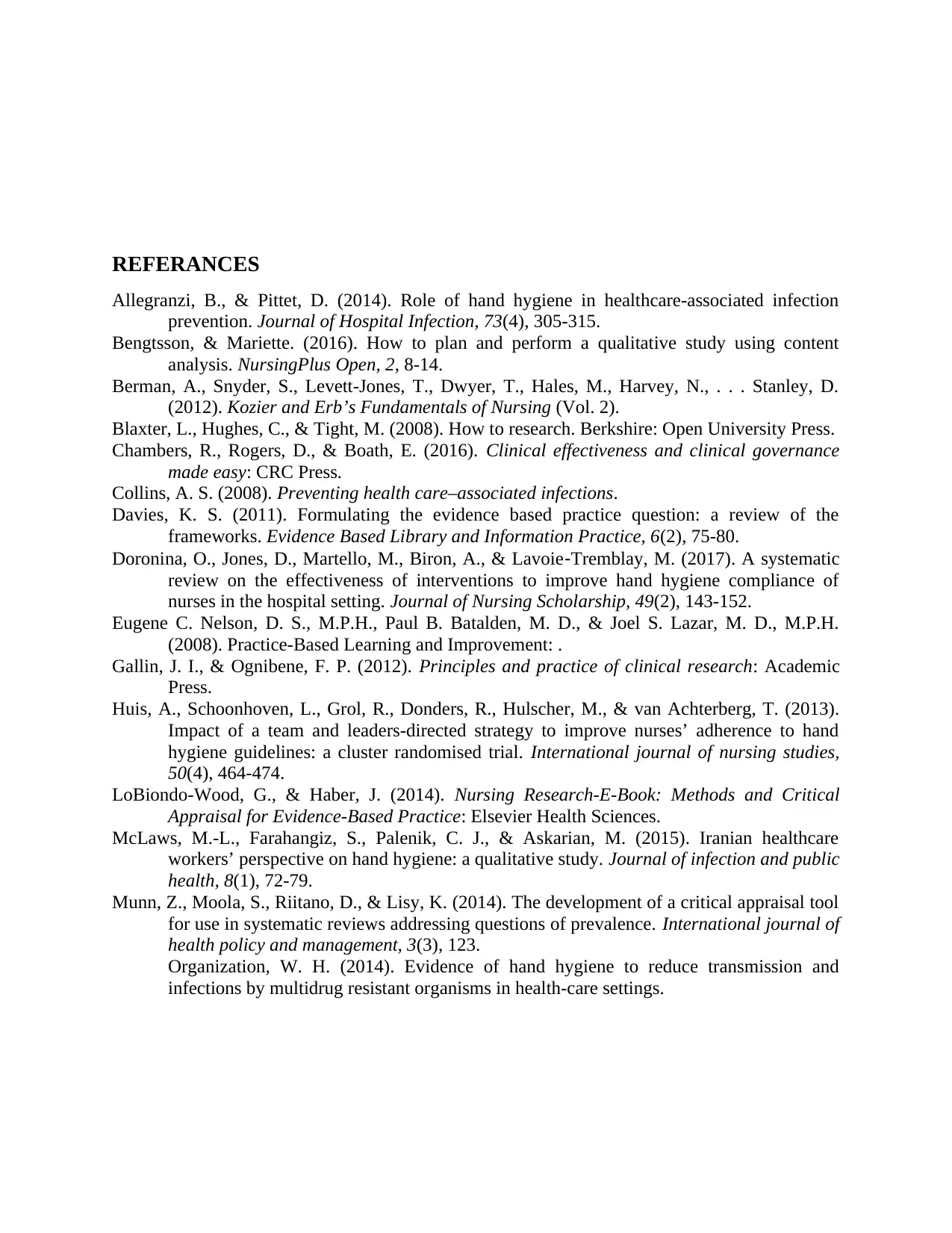
REFERANCES
Allegranzi, B., & Pittet, D. (2014). Role of hand hygiene in healthcare-associated infection
prevention. Journal of Hospital Infection, 73(4), 305-315.
Bengtsson, & Mariette. (2016). How to plan and perform a qualitative study using content
analysis. NursingPlus Open, 2, 8-14.
Berman, A., Snyder, S., Levett-Jones, T., Dwyer, T., Hales, M., Harvey, N., . . . Stanley, D.
(2012). Kozier and Erb’s Fundamentals of Nursing (Vol. 2).
Blaxter, L., Hughes, C., & Tight, M. (2008). How to research. Berkshire: Open University Press.
Chambers, R., Rogers, D., & Boath, E. (2016). Clinical effectiveness and clinical governance
made easy: CRC Press.
Collins, A. S. (2008). Preventing health care–associated infections.
Davies, K. S. (2011). Formulating the evidence based practice question: a review of the
frameworks. Evidence Based Library and Information Practice, 6(2), 75-80.
Doronina, O., Jones, D., Martello, M., Biron, A., & Lavoie‐Tremblay, M. (2017). A systematic
review on the effectiveness of interventions to improve hand hygiene compliance of
nurses in the hospital setting. Journal of Nursing Scholarship, 49(2), 143-152.
Eugene C. Nelson, D. S., M.P.H., Paul B. Batalden, M. D., & Joel S. Lazar, M. D., M.P.H.
(2008). Practice-Based Learning and Improvement: .
Gallin, J. I., & Ognibene, F. P. (2012). Principles and practice of clinical research: Academic
Press.
Huis, A., Schoonhoven, L., Grol, R., Donders, R., Hulscher, M., & van Achterberg, T. (2013).
Impact of a team and leaders-directed strategy to improve nurses’ adherence to hand
hygiene guidelines: a cluster randomised trial. International journal of nursing studies,
50(4), 464-474.
LoBiondo-Wood, G., & Haber, J. (2014). Nursing Research-E-Book: Methods and Critical
Appraisal for Evidence-Based Practice: Elsevier Health Sciences.
McLaws, M.-L., Farahangiz, S., Palenik, C. J., & Askarian, M. (2015). Iranian healthcare
workers’ perspective on hand hygiene: a qualitative study. Journal of infection and public
health, 8(1), 72-79.
Munn, Z., Moola, S., Riitano, D., & Lisy, K. (2014). The development of a critical appraisal tool
for use in systematic reviews addressing questions of prevalence. International journal of
health policy and management, 3(3), 123.
Organization, W. H. (2014). Evidence of hand hygiene to reduce transmission and
infections by multidrug resistant organisms in health-care settings.
Allegranzi, B., & Pittet, D. (2014). Role of hand hygiene in healthcare-associated infection
prevention. Journal of Hospital Infection, 73(4), 305-315.
Bengtsson, & Mariette. (2016). How to plan and perform a qualitative study using content
analysis. NursingPlus Open, 2, 8-14.
Berman, A., Snyder, S., Levett-Jones, T., Dwyer, T., Hales, M., Harvey, N., . . . Stanley, D.
(2012). Kozier and Erb’s Fundamentals of Nursing (Vol. 2).
Blaxter, L., Hughes, C., & Tight, M. (2008). How to research. Berkshire: Open University Press.
Chambers, R., Rogers, D., & Boath, E. (2016). Clinical effectiveness and clinical governance
made easy: CRC Press.
Collins, A. S. (2008). Preventing health care–associated infections.
Davies, K. S. (2011). Formulating the evidence based practice question: a review of the
frameworks. Evidence Based Library and Information Practice, 6(2), 75-80.
Doronina, O., Jones, D., Martello, M., Biron, A., & Lavoie‐Tremblay, M. (2017). A systematic
review on the effectiveness of interventions to improve hand hygiene compliance of
nurses in the hospital setting. Journal of Nursing Scholarship, 49(2), 143-152.
Eugene C. Nelson, D. S., M.P.H., Paul B. Batalden, M. D., & Joel S. Lazar, M. D., M.P.H.
(2008). Practice-Based Learning and Improvement: .
Gallin, J. I., & Ognibene, F. P. (2012). Principles and practice of clinical research: Academic
Press.
Huis, A., Schoonhoven, L., Grol, R., Donders, R., Hulscher, M., & van Achterberg, T. (2013).
Impact of a team and leaders-directed strategy to improve nurses’ adherence to hand
hygiene guidelines: a cluster randomised trial. International journal of nursing studies,
50(4), 464-474.
LoBiondo-Wood, G., & Haber, J. (2014). Nursing Research-E-Book: Methods and Critical
Appraisal for Evidence-Based Practice: Elsevier Health Sciences.
McLaws, M.-L., Farahangiz, S., Palenik, C. J., & Askarian, M. (2015). Iranian healthcare
workers’ perspective on hand hygiene: a qualitative study. Journal of infection and public
health, 8(1), 72-79.
Munn, Z., Moola, S., Riitano, D., & Lisy, K. (2014). The development of a critical appraisal tool
for use in systematic reviews addressing questions of prevalence. International journal of
health policy and management, 3(3), 123.
Organization, W. H. (2014). Evidence of hand hygiene to reduce transmission and
infections by multidrug resistant organisms in health-care settings.
⊘ This is a preview!⊘
Do you want full access?
Subscribe today to unlock all pages.

Trusted by 1+ million students worldwide

1 out of 10
Related Documents
Your All-in-One AI-Powered Toolkit for Academic Success.
+13062052269
info@desklib.com
Available 24*7 on WhatsApp / Email
![[object Object]](/_next/static/media/star-bottom.7253800d.svg)
Unlock your academic potential
Copyright © 2020–2025 A2Z Services. All Rights Reserved. Developed and managed by ZUCOL.





